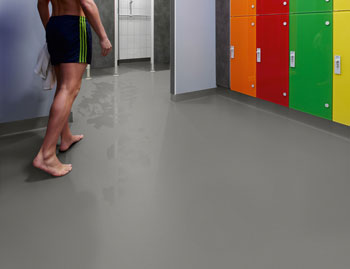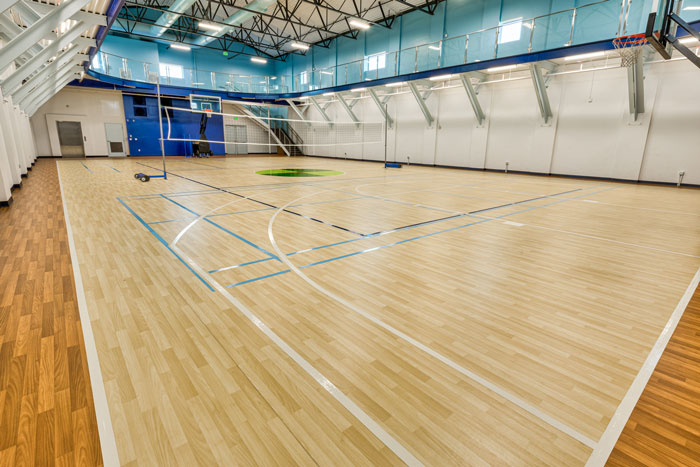Whatever the purpose of the space, a floor’s performance requires adherence to established standards or technical

guidelines. In most spaces, however, the floor is taken for granted as a passive surface, not a performing one.
A performance floor can be defined as a surface that responds to users in a way that supports and enhances their activities. The way the floor functions can improve performance when relying on three key benefits working together: safety, ergonomics and acoustics.
Acoustics
As occupant health and wellness become more important aspects of the built environment, ensuring good acoustics should be a fundamental part of the design process. The acoustical issues typically found in athletic facilities stem from the nature of their construction and the specified materials or surfaces. Many facilities are built as large, open spaces dominated by hard walls and ceilings that reflect sound, so the materials used on parallel surfaces must be strong and durable to isolate and dampen those sounds.
The array of sports and fitness programs available at athletic facilities is constantly growing and changing. In addition, the variety of indoor space allocated for them presents tremendous opportunities for architects to find unique solutions to acoustical problems.
New technologies in flooring allow for products, such as vinyl fused to a vulcanized composition rubber (VCR) backing, to combine the look of wood with the elasticity required for activities. For many sports applications, vinyl, rubber or synthetic turf layers with VCR backings provide optimal flooring choices for improving acoustics while keeping athletes safe and performing at top levels.
Ergonomics
“Ergonomics” refers to the mechanics of how the human body reacts to surrounding physical conditions and has real consequences for the health and productivity of people in all activities. An ergonomic chair is designed to support the body in ways that avoid injury and promote healthy posture, but what is an ergonomic floor?
A performance surface can provide support, prevent fatigue and injury, and promote good mobility. As with other elements of performance, balance depends on the activities in the space, and perhaps the most advanced area when it comes to putting performance first is the fitness environment. Data indicates performance flooring is vital to personal health and wellness, so it is important to examine its force reduction and energy restitution before selecting it for a space.
A classic comparison illustrating these concepts is a floor of concrete versus a beach of sand. Concrete has little force reduction (0%) and high energy restitution (77.2%), which means the floor returns virtually all the force of a footstep to the person walking. Conversely, sand has high force reduction (82.7%) and low energy restitution (0.5%). Virtually no energy is returned to the person; instead, it is all absorbed, has too much “give” and makes walking difficult.
Thousands of reps and repetitive motion is taxing on the body, so correctly pairing the activity with the surface is vital to preventing injury and fine tuning a training routine. Doing box jumps on a concrete surface versus one with a VCR backing could be the difference between a nagging hip injury and having toned quads.
Safety

The term “safety floor” typically refers to flooring used to improve traction in areas exposed to water, food or chemicals, such as locker rooms, pools or spas. However, safety is a much broader category of performance and a vital concern in almost every indoor space. A performance floor should contribute to reducing impact hazards and enhancing the ability of people to move freely.
Slip resistance, often measured by the Coefficient of Friction (COF), is the most familiar component of safety performance in flooring and one of the most important for selecting floors that prevent slips. However, falls inevitably occur, and since they can never be eliminated entirely, a performance floor should work to help prevent injury or reduce its severity.
Alternatively, an overly slip-resistant surface can hinder movement, posing safety concerns in gyms and fitness centers. Therefore, achieving the right balance of slip resistance and mobility is essential. In these scenarios, concepts often applied in sports and athletics, such as playability, sliding effect and head injury criteria, can guide surface selection and are valuable when determining a floor’s suitability for specific activities. In today’s active society, higher levels of physical activity may lead to an increased risk of falls. Flooring plays a pivotal role in mitigating the force of impact, thereby preventing and reducing fall-related injuries. RM
ABOUT THE AUTHOR
Bo Barber is the chief growth & innovations officer for Ecore, a company that transforms reclaimed materials into performance products that make people’s lives better and strives for a planet free of rubber waste. More information on the acoustic, safety and ergonomic surfaces Ecore provides is available at www.ecoreintl.com.



